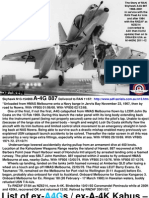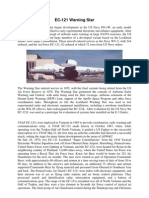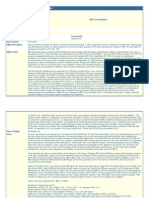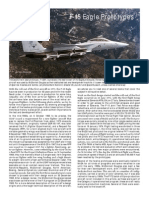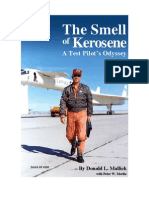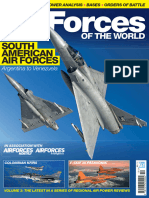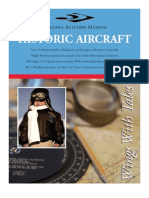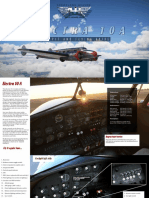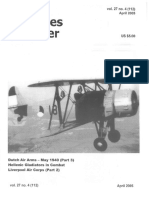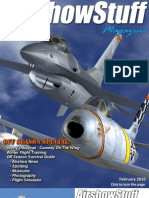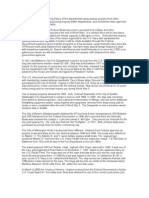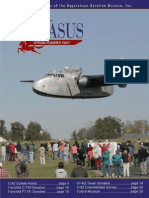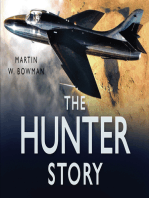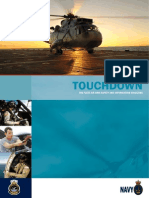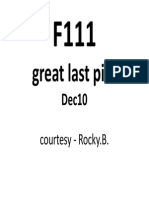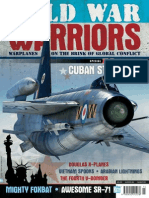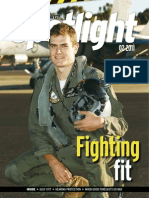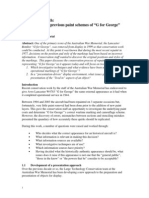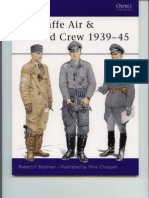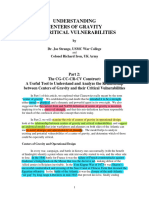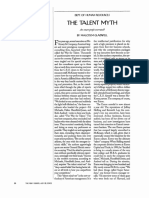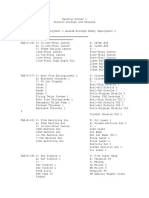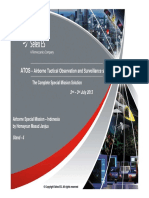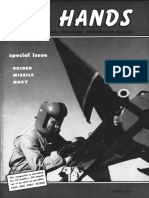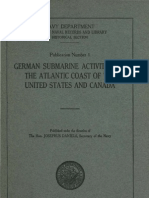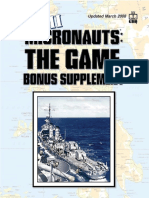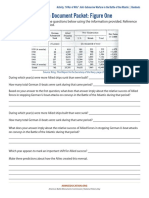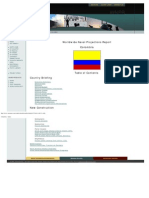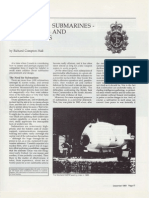100%(4)100% found this document useful (4 votes)
371 viewsSkyhawk Jet
Skyhawk Jet
Uploaded by
Humpty DumptyThe document summarizes the history of VSF (Very Small Fighters), squadrons that provided fighter aircraft protection for anti-submarine warfare (ASW) aircraft carriers from 1955-1973. Initially, fighter detachments deployed aboard ASW carriers came from other squadrons and used aircraft like the F9F Cougar and F2H Banshee. However, newer aircraft like the F-4 Phantom II were too large, so the smaller and more agile A-4 Skyhawk was adopted for the role. Various squadrons provided Skyhawk detachments aboard ASW carriers from 1961 onwards. In 1965, Anti-Submarine Warfare Fighter Squadron One (VSF-1) was
Copyright:
© All Rights Reserved
Available Formats
Download as PDF, TXT or read online from Scribd
Skyhawk Jet
Skyhawk Jet
Uploaded by
Humpty Dumpty100%(4)100% found this document useful (4 votes)
371 views12 pagesThe document summarizes the history of VSF (Very Small Fighters), squadrons that provided fighter aircraft protection for anti-submarine warfare (ASW) aircraft carriers from 1955-1973. Initially, fighter detachments deployed aboard ASW carriers came from other squadrons and used aircraft like the F9F Cougar and F2H Banshee. However, newer aircraft like the F-4 Phantom II were too large, so the smaller and more agile A-4 Skyhawk was adopted for the role. Various squadrons provided Skyhawk detachments aboard ASW carriers from 1961 onwards. In 1965, Anti-Submarine Warfare Fighter Squadron One (VSF-1) was
Original Description:
USN Skyhawk jet
Original Title
Skyhawk jet
Copyright
© © All Rights Reserved
Available Formats
PDF, TXT or read online from Scribd
Share this document
Did you find this document useful?
Is this content inappropriate?
The document summarizes the history of VSF (Very Small Fighters), squadrons that provided fighter aircraft protection for anti-submarine warfare (ASW) aircraft carriers from 1955-1973. Initially, fighter detachments deployed aboard ASW carriers came from other squadrons and used aircraft like the F9F Cougar and F2H Banshee. However, newer aircraft like the F-4 Phantom II were too large, so the smaller and more agile A-4 Skyhawk was adopted for the role. Various squadrons provided Skyhawk detachments aboard ASW carriers from 1961 onwards. In 1965, Anti-Submarine Warfare Fighter Squadron One (VSF-1) was
Copyright:
© All Rights Reserved
Available Formats
Download as PDF, TXT or read online from Scribd
Download as pdf or txt
100%(4)100% found this document useful (4 votes)
371 views12 pagesSkyhawk Jet
Skyhawk Jet
Uploaded by
Humpty DumptyThe document summarizes the history of VSF (Very Small Fighters), squadrons that provided fighter aircraft protection for anti-submarine warfare (ASW) aircraft carriers from 1955-1973. Initially, fighter detachments deployed aboard ASW carriers came from other squadrons and used aircraft like the F9F Cougar and F2H Banshee. However, newer aircraft like the F-4 Phantom II were too large, so the smaller and more agile A-4 Skyhawk was adopted for the role. Various squadrons provided Skyhawk detachments aboard ASW carriers from 1961 onwards. In 1965, Anti-Submarine Warfare Fighter Squadron One (VSF-1) was
Copyright:
© All Rights Reserved
Available Formats
Download as PDF, TXT or read online from Scribd
Download as pdf or txt
You are on page 1of 12
Page 26 THE HOOK, Spring 2006
Editors Note: VSF, or ASWFitRon, was a squadron that provided
fighter aircraft to the specialized anti-submarine aircraft carriers (des-
ignated CVS and operated from 1955 to 1973) to protect those ships
from enemy air attacks.
The two VSF squadrons (four, if Navy Reserve squadrons are
included) deployed only one detachment in their intended role, but
went to sea as normal attack squadrons. The detachments that did
deploy aboard CVSs came from fleet VA or Marine Corps squadrons.
The Blackbirds of VA-45, a fleet replacement squadron, came closest to
the original VSF concept on the last CVS cruises. Although used
officially for only a brief period, VSF is a convenient way of saying
fighters operating from an ASW aircraft carrier, and will be used as
such in this article.
C
arrier-based anti-submarine warfare did not begin as a specialty.
During World War II, all aircraft were used for anti-submarine
patrols even the fighters. After Korea, the increased capabili-
ties of submarines demanded specialized aircraft to detect, track and kill
them. The Grumman Avenger, which began life as a torpedo bomber,
was heavily modified to become the first dedicated carrier-based ASW
aircraft. The large, short-lived AF Guardian, which operated in a two-
aircraft team, followed for a short time before the multi-crew, multi-
engine S2F (later designated S-2) Tracker dominated ship-based ASW
for the next two decades.
Specialized anti-submarine carrier air wings (CVSGs) were created
consisting of two air anti-submarine (S-2) and a helicopter anti-
submarine (H-34/SH-3A) squadron, plus detachments for early warning
and ECM. A CVS with several surface combatants formed an ASW task
group (The Hook, Su 05) and usually operated far from shore- or
carrier-based air protection. The threat from Soviet long-range maritime
aircraft was indeed real, and the addition of fighters to the CVSG was
seen as the answer.
The concept was developed on three deployments. VF(AW)-4 Det 50
operated F9F-5 Cougars from USS Antietam (CVS-36) in late 1956
before she became the full-time training carrier in Pensacola. VA-44 had
later-model F9F-8 Cougars in Wasp (CVS-18) in late 1957 and VF-92
Det N flew F2H-3 Banshees from Yorktown (CVS-10) October 1958 to
May 1959. The fighter detachment concept worked well, prompting the
formation of more dets.
Enter the Skyhawk
However, newer, more capable Navy aircraft also were larger, heavier
and faster. In 1960 all eight CVSs had hydraulic catapults and limited
deck space and simply were not able to operate fighters such as the
Demon, Skyray or Crusader. Enter the A-4 Skyhawk.
The nicknames of Douglas A-4 Scooter, Tinker Toy, Heinemanns
Hot Rod reflected the aircrafts small size, light weight and agility.
VA-34 provided the first detachment of Skyhawks (A4D-2/A-4B) during
the 1961 Essex (CVS-9) Atlantic deployment. The Blue Blaster
Skyhawks carried a centerline fuel tank, two AIM-9 Sidewinders and two
20mm cannon for use in the air-defense role. This loadout would remain
standard. Eleven more detachments with A-4s on CVSs followed.
Vee Ess EffVery Small Fighters
by CDR Robert R. Boom Powell, USN(Ret)
Vee Ess EffVery Small Fighters
VA-34 Blue Blasters A4D-2 traps on board Essex (CVS-9), 6 Apr 61.
USN
USN, CDR Raoul Smiley Alvarez, USN
A VA-45 Det 1 A-4E Skyhawk loaded out with AIM-9 Sidewinder air-to-air
missiles and flying from USS Intrepid (CVS-11) keeps station on the wing of a
Soviet Tu-95 Bear during a 1972 intercept.
THE HOOK, Spring 2006 Page 27
VA-64 had a detachment of A-4Bs in Wasp from February to June
1962 before the entire squadron embarked in Independence (CVA-62)
for the Cuban quarantine. VA-22 provided four A-4B Skyhawks, six
pilots and 48 enlisted men (a typical VSF det size) on board Kearsarge
(CVS-33) from June to December 1963. A highlight of the Pacific
deployment was the recovery of space capsule Faith 7 with astronaut
Gordon Cooper on board.
The Marines Join the Party
The Marine Corps embarked its first det in 1963. Unfortunately,
Essex was hit by a huge storm returning from the Med during which the
steel mast broke off the top of the island. One of the yardarms punched
a hole through an H&MS-32 det Skyhawk and the wooden flight deck.
A planeload of jet fuel splashed over the flight deck and drained into the
hangar bay. Fortunately, there was no fire.
On the same deployment, a Soviet Tu-95 Bear made several low-
altitude runs over Essex, misjudged a turn and crashed spectacularly
into the sea within view of everyone on deck.
A det from the VMA-214 Black Sheep went to WestPac with A-4Bs
in Hornet (CVS-12) as part of CVSG-57 from October 1963 to April
1964. The VA-34 Blue Blasters had overlapping dets in Randolph
(CVS-15) and Intrepid (CVS-11) from late 1963 into 1964.
The Skyhawks turned out to be useful in the ASW role as well. With
their speed they could search wide areas visually or dash to a distant
contact much faster than the S-2. Submarines did not expect a threat
from high altitude. The Scooter pilots carried cameras and soon became
proficient at low passes to closely observe ships.
VA-93 deployed Det Q in Bennington (CVS-20) from February to
September 1964. Detachment pilot Bob Krall commented on shooting at
a banner towed by a T2V Sea Star, The deployment at Yuma didnt
produce any results that det pilots could brag about at a fighter-pilot bar.
Despite efforts at boresighting the guns, the A-4 was not suited for air-
to-air gunnery.
VA-153 Det R in Kearsarge made a fast turn in December 1964 to
join the parent squadron for deployment in Coral Sea (CVA-43).
VA-113 formed Det Q in Bennington in 1965. Marc Pierce, who later
would join VSF-1, remembers training with the F-8 RAG, VF-124, at
NAS Miramar. A-4s competed unofficially against F-8s with a TF-9
Cougar towing a target for air-to-air gunnery. Even with a fixed gun
sight, the Skyhawk pilots did better than the Crusaders with their lead-
computing sights, although experienced A-4 pilots versus
replacements new to the Crusader may have had something
to do with it.
Left, from top: VA-93 Det Q A-4B cruises near Mount Fuji, Japan, during the
1964 WestPac cruise on board Bennington (CVS-20). VA-93 Det Q Skyhawk
escorts a Soviet Tupolev Tu-16 Badger C. The admiral did not like postcard
shots like this and told the pilots to get closer. As a spoof, VA-93 Det Q painted
their noses black as if they had radar. The tail below the horizontal stab was also
black for a pretend tail-warning radar. Beriev Be-6 Madge intercepted by
Det Q OinC LCDR Tom Randall on 16 Jul 64. Note the A-4B is nose high to stay
with the piston-engined Madge. The Soviet seaplane was in the area conducting
SAR for a downed Badger. Below: VA-113 Det Q A-4B deployed in Bennington
from March to October 1965 with the standard configuration for the fighter
detachments 20mm cannon, two AIM-9 Sidewinders and a 150-gal. centerline
drop tank. The side number is a Roman numeral. The distinction of landing the
first A-4 Skyhawk on board the aircraft carrier HMAS Melbourne (21) went to
VA-113 Det Q in 1965, two years before the Australian navy had its own
squadrons of A-4Gs. Here, a Det Q A-4B is poised to launch from Melbournes
only catapult while a Supermarine Sea Venom and a pair of Fairey Gannets with
double-fold wings are parked to starboard.
USN
USN, LT Dave Boaz, USN
USN, LTJG Bob Krall, USN
USN
USN
Page 28 THE HOOK, Spring 2006
Like all the CVSs (except Intrepid) at the time, Bennington had
hydraulic catapults that restricted the A-4 to a 150-gal. centerline tank
with two AIM-9 missiles. During the deployment to WestPac, VA-113
Det had the unique opportunity to have the first U.S. Navy aircraft to
land aboard the Australian aircraft carrier HMAS Melbourne (21). With
the situation in Vietnam becoming more tense, VA-113s det also did a
fast turn to go aboard USS Kitty Hawk (CVA-63) in October 1965 for
the first strikes into North Vietnam.
The same year, the Bulldogs of VMA-223 Det T and their A-4Cs fin-
ished a deployment in Yorktown and immediately moved ashore to the
new Marine base at Chu Lai.
Marine Air Group 15s Headquarters and Maintenance Squadron
deployed to the Tonkin Gulf in Hornet as 1965 became 1966. The dets
six pilots flew bomb strikes along with their carrier protection mission,
and all made centurion. On a wry note, their A-4Cs were named for
ladies of dubious reputation Fanny Hill, Polly Adler, the Ko Sisters
and Mamie Stover.
VSF-1 The Early Days
The importance of the VSF mission and the success of dets to date
justified the creation of a specialized squadron that would provide a
detachment for each CVS. Protection of ASW task groups would be the
primary mission rather than the collateral role it had been. Anti-
Submarine Warfare Fighter Squadron One was established 1 July 1965
at NAS Lemoore. Plank owners included CDR Charles E. Waring, a
lieutenant and a dozen enlisted men. The squadron would be based at
NAS Alameda and was to be assigned A-4Bs.
The first commanding officer, CDR Waring, had flown 65 missions in
F4U-4 Corsairs in Korea in VF-54 from Philippine Sea (CVA-47) and
Valley Forge (CVA-45). He made Midways (CVA-41) around-the-world
cruise in VF-174 flying F9F Cougars and was XO of VA-155 flying
A-4A/Bs in WestPac on board Coral Sea. Recently promoted after
several years in Izmir, Turkey, with the 6th Allied Tactical Air Force,
Waring was assured by the commander detailer and legendary LSO,
CDR Toby Tobin, that the VSF assignment was a good deal.
The first pilots went through an abbreviated syllabus at Lemoore.
Since Waring was already A-4 qualified, he was finished with VA-125
after only two refresher hops. Later pilots bound for VSF-1 went
through the entire attack/nuclear-delivery syllabus and as a bonus,
they earned per diem while at Lemoore, because their final orders were
to NAS Alameda.
The eagle head featured in the squadron insignia was adapted from
the Waring familys silverware, with green slashes added to match the
painted portion of the A-4s rudder. Waring argued that as a fighter
squadron, VSF-1 should have red as the squadron color. Although pow-
ers that be decreed otherwise, the skippers airplane always seemed to
feature red while the rest of the squadron was painted green.
Left: A VMA-233 Det T A-4C traps on board Yorktown (CVS-10) during the
1965 cruise. Top: Mamie Stover A-4C of H&MS-15 Det N being led up the
deck of Hornet (CVS-12) by a tillerman with his steering bar through the nose-
wheel. Bomb symbols on the intake are for missions into Vietnam when not acting
as fighter protection for the ASW Group. Above: H&MS-15 maintenance person-
nel in front of Fanny Hill in this cruisebook photo.
CDR Doug Siegfried, USN(Ret)
USN
U
S
N
SULTRY LADIES AT SEA
D
uring more liberal times, the Marines of H&MS-15 Det N
serving as anti-submarine fighter protection in USS Hornet
(CVS-12) from August 1965 to March 1966 gave their four
A-4C Skyhawks names that were in florid script on the nose of their
birds:
BuNo 147681, YV 81 Fanny Hill
BuNo 147809, YV 82 Polly Adler
BuNo 147829, YV 83 Mamie Stover
BuNo 148464, YV 84 Ko Sisters
Fanny Hill The 1749 book is subtitled Memoirs of a Woman
of Pleasure. Considered the first erotic novel, it has become a
byword for censorship controversy.
Polly Adler A New York City madam in the 1930s who was
famous for entry scenes at Manhattan night clubs with her girls.
Mamie Stover A woman of dubious morals forced to leave San
Francisco for Hawaii in a 1956 novel. Suggestive mostly because of
the movie version with Jane Russell.
Ko Sisters Japanese womens names tend to end in ko, and
since most Marines did not have much command of Japanese, it was
a standard way to refer to Michiko, Fumiko, Sajiko, Akiko and the
other girls who worked in the o club at Iwakuni and the bars in town.
THE HOOK, Spring 2006 Page 29
VSF-1s aircraft side numbers began with
the COs 70 and eventually reached into
the 90s. Assigned the letter code NA,
squadron jokesters claimed it stood for
Not Applicable.
Waring was a skipper from the old
school. LTJGs Howie Fowler and Fred
Kasch arrived with the author at
Alameda from VA-125 at the same
time. Waring welcomed us by putting
us on the next days flight schedule.
No chase, no old-hand along to watch
us just the three of us taking turns
leading the flight. Howies family was from a town near Mount Shasta
in Northern California, so we flew up there to say hello. Fred and I were
tucked in tight for the fly-by when the radio call came, On count of
three, we pull up! I looked forward to see lots of green trees and steep
cliffs filling the Scooters windscreen.
Eager to develop the fighter mission, Charlie Waring arranged
weapons detachments to NAS Fallon and MCAS Yuma, set up combat
maneuvering practice and fired AIM-9 Sidewinders. Also, he directed
that Rudolf be built.
Rudolf was an A-4B (BuNo 145002) that featured an F-8 air-to-air
radar borrowed from the China Lake Weapons Center and installed by
NARF Alameda. The unique, longer nose, modified from the nose of an
F-11 Tiger, was painted red and the name naturally followed.
What was intended as the prototype for future VSF fighters had not
been approved by higher authority. Neither was taking Rudolf on the
carqual sessions scheduled for VSF-1 pilots on Kearsarge and Hornet.
Waring himself flew Rudolfs first trap.
Cancellation of a planned det in Yorktown in 1966 was the first hint
that the squadrons VSF mission was about to change. The change
became official when VSF-1 was assigned to Shangri-La (CVA-38).
The war in Southeast Asia was heating up and attack assets were needed
there desperately. To fill the requirement, an Atlantic Fleet VA squadron
was to deploy to WestPac, and VSF-1 was scheduled to take the
squadrons place in a deployment to the Med in November 1966 as a
normal-size attack squadron.
With a large number of pilots and aircraft in the pipeline headed for
VSF-1, a second attack squadron was to be formed, and both would
retain the VSF designation. In what turned into administrative mayhem,
VSF-1 Det Alameda grew larger than its parent organization, at sea half
a world away.
The shift to becoming an attack squadron began immediately with the
squadron launching a weapons det to Fallon and bombing and rocket
practice at NALF Crows Landing, just across the mountains in the cen-
tral San Joaquin Valley. VSF-1 also used Crows Landing for field carrier
landing practice before it headed east to join CVW-8 at NAS Cecil Field
and the Med deployment.
Four pilots, including ex-NavCad ENS Al Cartwright, were called
upon to report to Billy Phillips Air Wing 19 to replace pilots he was less
than happy with. Cartwright said leaving
VSF-1 was hard not because he was
headed to WestPac, but because Waring was
so good to work for. Several combat limited,
(i.e., combat deployment veterans) arrived to
fill the vacant slots.
VSF-1 in the Med
After six weeks of work ups on the East
Coast, Shangri-La departed Norfolk on
29 September 1966. On board were the War
Eagles of VSF-1 with 14 A-4B Skyhawks. The
tail code was now the AJ of Air Wing Eight
and side numbers temporarily began with 570.
Other than a junior pilot landing hard enough to break the wing of an
A-4 during a dive-for-deck trap at night, the time in the Med in support
of 6th Fleet operations was routine, and all War Eagle pilots became
Shang Centurions. CDR Donald K. Wilson assumed command of
VSF-1 on 14 April 1967 while the ship was in Palermo, Sicily. Soon
afterward, Shangri-La returned to Norfolk and VSF-1 flew back to NAS
Alameda.
VSF-3 Is Formed
VSF-3 was established in March 1967. CDR Leslie C. Hofto went
from XO of VSF-1 to officer in charge Det Alameda and finally to com-
manding officer of VSF-3.
Hofto began his flying career in AD
Skyraiders and was assigned to the
CVG-7 staff as LSO. He made a Med
deployment before going to combat in
Korea in Bon Homme Richard
(CVA-31). Then he extended for three
months to assist CVG-15/Princeton
(CVA-37) LSOs who were unfamiliar
with jets. Hofto later was senior LSO
in Bennington for the legendary recov-
ery during the Mariner Miracle (The
Hook, Wi 91). After a Washington,
D.C., tour, he found himself in a quiet
but fun assignment as director of the Navy/ Marine Corps exhibit at the
1964 NewYork Worlds Fair.
His detailers call with assignment to VSF-1 was as confusing as it
was for most. The author remembers that, as a red-hot jet pilot with
shiny new wings, his heart stopped in the pause between VS and F
One for his first squadron. Hed thought the detailer meant
VS, or an air-anti-submarine squadron flying Grumman
S-2 Trackers.
Clay Jansson
USN
A-4B BuNo 145002, which after modifications to add an F-8 radar to the nose,
should have become the YFA-4B. Late on 28 Oct 66 at NAS Alameda, Clay
Jansson took one photo and was asked to not shoot that airplane, so he moved to
the next but kept Rudolf in the frame. The sensitivity was probably more about
the unapproved modifications than any classified equipment.
VSF-1 deployed to the Mediterranean on Shangri-
La (CVA-38) from Nov 66May 67 as an attack
squadron with 16 A-4B Skyhawks. Side numbers at
first began with 570 and were later changed to a
more conventional 500 series; the squadron color
remained green.
Page 30 THE HOOK, Spring 2006
Achieving notoriety early in the squadrons life, VSF-3 made televi-
sion news and newspaper headlines in late 1966 with a Navy Bombs
Oakland! banner after a Mk 76 practice bomb fell into one of the few
vacant lots in that city. A flight of four had launched from NAS
Alameda, and as Dash 3 closed in, he asked, Two, how many bombs
did you have when you took off?
Six. (pause) Why?
Well, you only have five now.
Additional proof of VSF being short for Very Screwy Fellas was
VSF-3s assignment to CVW-10 and Intrepid (CVS-11). Air Wing10
and the other two of its A-4 squadrons were at NAS Cecil Field in
Florida. Intrepid was in Norfolk.
Lessons learned in Vietnam dictated increased ECM capabilities and
the Shoehorn installation a package of several ALQ-designated
jammer/warning/deceiver black boxes developed for the A-4. Aptly
named for the difficulty of finding space to install the magic black
boxes, the modification involved removing the port cannon and leaving
the other with only 40 rounds. BuNo 154002, the Skyhawk with the spe-
cial nose, was among the aircraft reworked at NARF Alameda. With the
modification complete, the aircraft emerged as a standard A-4B
Rudolf was no more.
While the parent squadron was deployed in Shangri-La, the VSF-1
det made two 10-day visits to Fallon for weapons practice and flew a
carqual session in Bon Homme Richard. After the det was established as
VSF-3, the squadron carrier qualified in Kearsarge before joining
Intrepid in Norfolk. Work ups on the East Coast continued for the next
two months with few chances for visits to Alameda. Finally, the
squadron airplanes were taxied from NAS Norfolk to the naval base and
hoisted aboard Intrepid for the voyage to war the long way.
VSF-3 Deployed
Middle East tensions were high, and Jordan had signed a treaty with
Egypt while Intrepid was in the eastern Mediterranean. Aircraft were
armed and crews put on alert. After several days of uncertainty, Intrepid
entered the Suez Canal in June 1967, and all hands were restricted from
Charlie Eagles
Service to VSF-1
C
harlie Eagles service with the Navy began when a SAR heli-
copter crew rescued an injured red-tailed hawk and took the
bird back to NAAS Fallon. Navy corpsmen removed the bird-
shot, but its wing was severely damaged and his flying days were
over. Since the hawk could not be released into the wild, the folks at
Fallon kept it.
The commanding officer of Fallon, CAPT Frederick W. Oliver,
was wondering what to do with his charge when brand-new VSF-1
arrived for weapons training. Emblazoned proudly on the pilots
flight jackets and A-4B airplanes was the squadron patch inspired by
the first COs family crest an eagle head en profile on fesse vert.
A hawk looks like an eagle, especially a stylized one. And the
squadron flew Skyhawks. It was a perfect match. A small ceremony
was arranged and the hawk was officially presented as the mascot for
VSF-1. How could the CO, CDR Charlie Waring, refuse?
At the end of the weapons training, the transport folks who were
to fly the squadron troops and equipment back to NAS Alameda
balked at carrying a live animal against regulations, you know
until skipper Waring persuaded them.
The sex of the bird was never determined, but it was soon named
Charlie Eagle. The airframes shop built a large cage painted in
VSF-1 green and placed it at the back of the ready room on the sec-
ond deck looking out over the flight line, the Alameda runways and
the Oakland Bay Bridge crossing to San Francisco.
ENS Al Cartwright, the squadrons most junior officer, was put in
charge of Charlie. Much to the chagrin of the authorities, Cartwright
raised mice in the Alameda BOQ to feed the hawk. After he trans-
ferred to CVW-19 Charlies diet became raw liver with an occasional
lizard caught by maintenance officer Phil Doughertys nine kids.
However, Charlies gory mouse meals continued as part of the ini-
tiation of new men into the squadron. LT (later RADM) Dan March
would buy mice at a local pet shop. When the sweet old lady clerk
questioned why he bought so many, Dan responded with a straight
face that they kept escaping from their cage.
As the door to his cage was usually open, Charlie would hop onto
chair backs and up to the top of the cage. From there he would occa-
sionally launch for the front of the room, hit the waxed linoleum
deck and skid into the wall. These flights went into the squadron
log as arrested landings. On other occasions, Charlie would target
the squadron duty officer at his desk. Looking up into the out-
stretched talons of a hawk was a thrill experienced by most of the
junior officers serving as SDO. Mercifully there were no injuries
to bird or duty officers.
Deciding that mice and lizards were insufficient for a warhawk, a
guinea pig was purchased for sacrifice. As a crowd of officers
watched, the guinea pig was tossed into the cage, saw the hawk and
immediately froze. Charlie sat on his perch turning his head side to
side as he studied this round, furry, oversize mouse. After many
suspenseful minutes, the guinea pig decided there was no danger and
began snuffling around the cage.
That was too much for Charlie, who dived on the guinea pig,
talons extended and ready for lunch. The guinea pig sensed the
attack, whirled, and bit Charlies foot. The hawk squawked and
retreated to the back of his cage. Having successfully stood his
ground, the guinea pig was removed from danger and went home to
the Dougherty kids.
With VSF-1 scheduled to deploy, Charlie was passed to VSF-3 to
continue his service as a mascot. When time came for the
squadron to deploy as well, Charlie Eagle was sent PCS to
the Oakland Zoo, where he outlived both the squadrons.
CAPT Frederick Oliver (right), commanding officer of NAAS Fallon, presents
the red-tailed hawk which would become the VSF-1 mascot, to the squadrons
commanding officer, CDR Charlie Waring.
USN
CDR Robert Boom Powell, USN(Ret)
VSF-3 A-4B on fighter alert with two AIM-9 Sidewinders during Intrepids
(CVS-11) transit to or fromYankee Station in 1967.
THE HOOK, Spring 2006 Page 31
the weather decks for the transit. Although there were overflights by
Egyptian fighters and troops were sighted on the banks of the canal, the
worst the Egyptians did was display banners and shake their shoes at the
ship. The Arab-Israeli Six Day War began four days later. Intrepid was
the last warship to go through the canal until it was reopened in 1975.
The two-week transit to the Pacific was filled with all-pilot meetings
for training and briefings. Two meetings a day were the norm, and for
VSF-3, the meetings usually ended the same way the new squadron
needed an insignia. Sketches of half a dozen candidates were presented
and discussed. The selection was whittled down to two, with a final
choice to be made the next day. By the next day, other options appeared
and the choices were back up to five or six.
The final compromise was a knight chess piece on a checkered field
with red jags to match the tails of the squadrons aircraft. The agreed-
upon name was Chessmen.
The radio callsign Nevada City had been used by both VSF-1 and
VSF-3 from the beginning. There was a small town of the same name
on the western slope of the Sierra Nevada, which prompted many low-
level flights to the area to check out the namesake.
After a brief stop in Subic Bay, Republic of the Philippines, and adja-
cent NAS Cubi Point, VSF-3 entered combat for the first time on
21 June 1967. The veterans of VA-15 who had been with Intrepid the
previous year assumed that operations would begin again on Dixie
Station and eventually work their way north.
They were wrong. The air war in the summer of 1967 was at full
pace. VSF-3 operated over North Vietnam for its first missions. By the
end of the first line period it was flying over the Haiphong suburbs and
over the Big Hs (Hanoi and Haiphong) by the second line period.
Though many aircraft returned to Intrepid with battle damage, only
two were lost. LTJG Fred Kasch was the squadrons only fatality. Early
in July, he was hit by AAA over Hai Duong and crashed while trying to
glide his flamed-out Skyhawk to safety in the Tonkin Gulf. His wing-
man, ex-NavCad LTJG Dick Harriss, heard him call, Im at 500 feet.
Harris told him to get out, but there was no apparent ejection. The Navy
listed Kasch as MIA until his remains were returned in 1989. He was
flying BuNo 145002, the A-4B once known as Rudolf.
In October 1967 LTJG Al Perkins was hit by AAA while on a flak-
suppression mission over Haiphong. Perkins, wounded in the leg, barely
could control his airplane. As he jettisoned his canopy in an attempt to
clear the dense smoke in the cockpit, he was either hit again or his
engine exploded. Perkins ejected and landed in Haiphong Harbor, where
an H-2 Seasprite helicopter from HC-1 picked him up a few yards away
from an enemy ship.
Once in WestPac, although Intrepid picked up a VFP-63 photo-
Crusader detachment and VF-111 provided three F-8Cs and four pilots,
VSF-3 was considered the carriers resident fighter squadron. The
squadron color was red, Ready Room One, nearest the flight deck, was
assigned, though shared with the Sader pilots. During ship transits, the
squadron stood flight deck alerts in an A-4B with a centerline fuel tank
and a pair of AIM-9 Sidewinders on the rails.
On 5 October 1967, Air Wing 10 Skyhawks encountered MiGs in
force. A 27-plane Alfa strike had launched against a target
near the Kien An Airfield. During the egress, half the strike
group ran into MiGs. Dick Harriss was first aware of them
Wednesday, 10 May 2006
13001700 Golf Tournament (A.C. Read Golf Course)
Thursday, 11 May 2006
07450830 Navy Band Concert (Atrium)
08300930 Hall of Honor Enshrinement
VADM Donald E. Engen, USN*
CAPT Arthur Ray Hawkins, USN*
CAPT R. E. Mitchell, MC, USN (Ret)
CAPT Eugene A. Cernan, USN (Ret)
*Deceased
09451145 Session I: Remarkable Rescues (Atrium)
Moderator: VADM Donald C. Thompson, USCG (Ret)
Panelists: CAPT Ted Le Feuvre, USCG
CAPT Bruce C. Jones, USCG
CDR Stephen H. Torpey, USCG
LCDR Joseph E. Balda, USCG
LT Michael Odom, USCG
AETC Fred Kalt, USCG
AST2 David M. Yoder III, USCG(Ret)
12001315 Luncheon (Flight Deck)
Guest Speaker: Mr. Cliff Robertson
13301530 Session II: Incredible Night Combat Rescue!
Moderator: RADM Frederick L. Lewis, USN(Ret)
Panelists: CAPT John A. Burns, USN(Ret)
CAPT John W. Holtzclaw, USN(Ret)
CDR C. LeRoy Cook, USN(Ret)
Mr. Bruce Dallas
19002100 Opening Reception (Quarterdeck)
Friday, 12 May 2006
09000945 Navy Band Concert (Atrium)
09451130 Session III: Naval Aviation:
Issues and Answers (Atrium)
Moderator: VADM James M. Zortman, USN (CNAP)
Panelists: To Be Announced
18151900 Reception (Flight Deck)
19002100 Banquet (Atrium) Speaker: The Hon. B. J. Penn
Symposium 06
Remarkable Rescues: Courtesy USCG
Where Do We Get Such Men?
An Incredible Night Combat Rescue!
Naval Aviation: Issues and Answers
Naval Aviation Museum Foundation
P.O. Box 33104, NAS Pensacola, FL 32508-3104
(800) 327-5002 or (850) 453-2389
The Naval Aviation Museum Foundation Presents
CDR Robert Boom Powell, USN(Ret)
Another view of an Intrepid VSF-3 A-4B on fighter alert, 1967.
Page 32 THE HOOK, Spring 2006
when he saw tracers coming down past him. He fired at the overshoot-
ing MiG but saw no hits and, out of ammo, Harriss headed for the water.
The official account of the action is typically confused, but at least six
different MiG-17s were involved.
CDR Georges LeBlanc, XO of VSF-3, maneuvered behind a MiG
and squeezed the trigger. His one cannon fired once and jammed. He
called for his wingman, LTJG Dan Swinford, to close in, but Swinford
had no radio. Both Skyhawks broke off and cleared the area.
The Air Wing 10 operations officer, Ed Gilreath, was flying VSF-3s
AK 107. When he heard the MiG warnings, he held the rockets he
carried for his flak suppression mission and headed for Kien An. His
wingman, LTJG D. Huey LHerault in AK 105, had fired all his
rockets at the assigned target. He describes what followed:
As we circled behind the strike group of Intrepid A-4s to fol-
low them feet wet, I made the initial visual of a single MiG-17
at about ten oclock low we were at about three hundred knots
and five or six thousand feet.
As I was in trail on Ed at full power, he called to arm up our
guns, and we turned hard left and initiated a dive toward the MiG.
The enemy aircraft then turned hard right, and as we made a
reversal to follow, I glanced behind me and there were three
MiG-17s flying a loose formation and firing tracer cannon rounds
at me. I called Ed to break hard right, and from there I ended up in
a one-v-three for three reversals. Somehow I avoided their bullets.
In the midst of this I saw Ed only one time, and that was to see
a stream of 2.75-inch rockets fill the air [AK 107 had fired eight
Zuni five-in. rockets and 20mm cannon earlier] as he made an
almost head-on pass at the three guys concentrating on me. When
the MiGs split two went high and one went low Ed called to
jettison all externals [fuel tanks, racks and rocket packs] and we
headed directly out to sea. At full speed with about fifteen hun-
dred pounds of gas left, we went right down on the deck. I
remember seeing airspeed of over five hundred fifty knots.
The last missions were flown at the end of November 1967. Most of
the flight crews were to fly home on a Magic Carpet airliner from
Clark AFB. An unlucky few officers and most of the men remained on
board Intrepid for the month-long voyage across the Indian Ocean,
around the Cape of Good Hope and across the Atlantic to Norfolk.
Due to a jurisdictional quirk, those pilots due to be airlifted back
could not depart from Clark until Intrepid chopped to the Atlantic
Fleet somewhere in the Indian Ocean. The pilots spent a boring week at
Cubi playing touch football early in the morning before it got too hot,
followed by swimming and afternoon naps. At least they could go to the
oclub for a legal drink and they were not getting shot at.
1968
The decision to standdown VSF-3 was made while the squadron was
in the Tonkin Gulf. When hearing the news, the pilots speculated that
they would be sent to A-4 or A-7 fleet squadrons, since they had only
the one combat deployment. However, BuPers considered all the time
spent in VSF, including time at Alameda for those who were in VSF-1
or the det, to be sea duty. Distribution was varied, with about half going
to sea-going squadrons. Alameda-based VA-152 had returned from
WestPac in Oriskany (CVA-34) and was transitioning from A-1
Skyraiders to A-4 Skyhawks. A cadre of pilots transferred from VSF-3
and at one point, VA-152 owned a dozen Spads and a mix of 14 Bravo
and Charlie Skyhawks. A few ex-VSF-3 A-4Bs went to the Navy
Reserves, while others were reworked and sent to Argentina where they
later flew in the Falklands War.
VSF-1 Med Deployments II and III
VSF-1 began transitioning to the A-4C in
August. The second cruise began in April
1968 with CDR Marty Asbacher the new CO.
The War Eagles spent their second Christmas
deployed, in Athens this time, and were con-
sistently the top flight-time squadron aboard
Independence.
In late 1968 Wasp was operating in the
Mediterranean and VSF-1, as well as VA-76,
provided temporary detachments to the
smaller carrier, though the dets were never
very far from the parent squadrons on board
Independence.
USN USN
LTJG Fred Kasch, USN
Left: The commanding officers A-4B from the full-strength VSF-1 traps on
board Shangri-La during the 196667 Med deployment during which all pilots
became CVA-38 Centurions. Above: Photo-op in 1966 for Howie Fowlers
Northern California hometown newspaper. Fowler is at right, author Powell by
NA 93. Coincidentally, both pilots later flew RA-5C Vigilantes.
In 1966 LTJG Fred Kasch (the only pilot lost when
VSF-3 went to Vietnam) used his new SLR camera
to photograph the author, then-LTJG Powell, over
the Golden Gate Bridge in a VSF-1 A-4B soon after
the squadron transitioned to the attack role.
THE HOOK, Spring 2006 Page 33
Returning to Alameda early in 1969, VSF-1 experienced a 50 percent
turnover of pilots and received a batch of new Skyhawks. The training
situation was complicated because VSF-1 was to revert to its original
anti-submarine support mission in January as well as remain committed
to CVW-7 in a contingency status. During work ups with Independence,
the squadron received extra personnel to accommodate a planned
Yorktown detachment. Independence and Yorktown left together for
NATO exercise Operation Peacekeeper in the North Atlantic. The VSF-1
det intercepted a Soviet Bear two days before the actual exercise the
only deployment of VSF operating in its intended role was under way.
During the subsequent visit to Portsmouth, England, in September,
word of VSF-1s coming disestablishment arrived. The det stayed out
until 11 December, and by the first day of 1970 no ASWFitRon existed
as a front-line unit.
Reserves as VSF
VSF-11Xl and -11X2 were created on paper in July 1968 at NAS
New Orleans as part of the reorganization of the Naval Reserve. Flying
A-4B Skyhawks, these squadrons, planned as full-size units, were soon
reduced to only four pilots. Another shake-up of the Reserves resulted
in the squadrons being designated VSF-76 and VSF-86, both squadrons
to be fully manned and equipped with A-4C/L Scooters. While neither
squadron made any full deployments, the Flying Saints and the Gators
were at sea for two-week AcDuTra cruises in 1971 in Wasp,
Ticonderoga (recently designated CVS-14) and Randolph.
After flying A-4s and A-7s on active duty, Ed Moir had joined the
Reserves, and was among the Gators pilots. He said:
Our squadron stood up as VSF-86, part of NAS North Island-
based CAG 80 under CDR Tom Stanley. Our fighters were
A-4Cs equipped with high-temperature J65 engines, and we flew
with centerline tanks only or sometimes
slick. Though not performing badly for a
Scooter, it still wasnt a fighter. We had fun
and the mission was super hassling and
more hassling. The flight deck crew on
Tico, despite having no recent jet experi-
ence, did a great job.
We held our change of command ceremony in Ticonderoga
under way in the San Diego operating area in the first Navy
Reserve change of command held at sea. Incidentally, the incom-
ing CO, Tammy Etheridge, later made rear admiral, as did a
squadron member, Dave Griggs.
The embarrassment of a Cuban airliner landing unannounced at New
Orleans Airport prompted a local congressman to have both Reserve VSF
squadrons assigned six F-8H Crusaders each to NAS New Orleans. It
was the first fighter in the VSF role since VF-92s Banshees in 1959. The
powers that be decided not to carqual the Reserves in the F-8, and with
approximately one pilot for each Crusader, it was a flying club of the
first order. The fun lasted a little more than a year, but with the CV con-
cept in effect and no CVSs remaining in the fleet, VSF-76
and VSF-86 were disestablished in 1973. Assigned personnel
and aircraft became the nucleus of todays VFC-13.
USN
USN
USN
USN
Above: A VSF-1 A-4B tanks an always-thirsty VF-13 F-8D. Above, right: A
VSF-86 A-4L at NAS New Orleans. Right: A VSF-86 A-4L bearing USS
Ticonderoga (CVS-14) markings during a two-week AcDuTra cruise in 1971.
Section of VSF-1 A-4Bs hawk the delta pattern over-
head Shangri-La on the 1967 Med cruise.
Page 34 THE HOOK, Spring 2006
Fighter Dets on CVSs and VSF Deployments
Squadron Det Aircraft Carrier Dates Place
VC-4 Det 39 F4U-5N USS Antietam (CVS-36) 15 Feb29 Mar 1954 Caribbean
VC-4 Det 50 F4U-5N USS Antietam (CVS-36) 12 Apr 1954Aug1955 *Atlantic
VC-3 Det N F4U-5N USS Princeton (CVS-37) 2 Nov 195431 May 1955 WestPac
VC-4 Det 51 F4U-5N USS Leyte (CVS-32) 1 Sep25 Sept 1955 Atlantic/Caribbean
VFAW-4 Det 50 F9F-5 USS Antietam (CVS-36) 25 Sep22 Dec 1956 Atlantic/Mediterranean
VA-172 Det 38 F2H-2 USS Tarawa (CVS-40) 3 Sep22 Oct 1957 Caribbean
VA-44 Det 48 F9F-8 USS Wasp (CVS-18) 3 Sep23 Oct 1957 North Atlantic
VF-92 Det N F2H-3 USS Yorktown (CVS-10) 31 Oct 195822 May 1959 WestPac
VA-34 A4D-2 USS Essex (CVS-9) 329 Apr 1961 Caribbean
VA-64 Det 48/18B A4D-2 USS Wasp (CVS-18) 18 Feb6 Jun 1962 North Atlantic
VA-22 Det R A-4B USS Kearsarge (CVS-33) 19 Apr 3 Dec 1963 WestPac
VA-83 Det 18 A-4B USS Wasp (CVS-18) 22 Apr 3 May 1963 Caribbean
H&MS-32 Det 1 A-4B USS Essex (CVS-9) 1 Oct 23 Dec 1963 Atlantic
VMA-214 Det N A-4B USS Hornet (CVS-12) 9 Oct 196315 April 1964 WestPac/Vietnam
VA-34 Det 11 A-4C USS Intrepid (CVS-11) 3 Dec 196313 Feb 1964 Caribbean
VA-153 Det R A-4B USS Kearsarge (CVS-33) 19 Jan16 Dec 1964 WestPac/Vietnam
VA-34 Det 15 A-4C USS Randolph (CVS-15) 22 Jan14 Feb 1964 Atlantic
VA-93 Det Q A-4B USS Bennington (CVS-20) 20 Feb11 Aug 1964 WestPac
VMA-223 Det T A-4C USS Yorktown (CVS-10) 23 Oct 196417 May 1965 WestPac/Vietnam
VA-76 Det 9 A-4C USS Essex (CVS-9) 820 Feb 1965 Atlantic
VA-113 Det Q A-4B USS Bennington (CVS-20) 22 Mar 7 Oct 1965 WestPac/Vietnam
H&MS-15 Det N A-4C USS Hornet (CVS-12) 12 Aug 196523 Mar 1966 WestPac
VSF-1 CVW-8 A-4B USS Shangri-La (CVS-38) 29 Sep 196620 May 1967 Mediterranean
VSF-3 CVW-10 A-4B USS Intrepid (CVS-11) 11 May30 Dec 1967 WestPac/Vietnam
VSF-1 Det 18 A-4C USS Wasp (CVS-18) 20 Aug19 Dec 1968 Atlantic/ Med
VSF-1 CVW-7 A-4C USS Independence (CVA-62) 30 Apr 196827 Jan 1969 Mediterranean
VSF-1 Det 10 A-4C USS Yorktown (CVS-10) 2 Sep11 Dec 1969 North Atlantic
VA-45 Det 11 CVSG-56 A-4C USS Intrepid (CVS-11) 16 Apr 15 Oct 1971 Mediterranean
VSF-86 CVSGR-80 A-4C USS Ticonderoga (CVS-14) 24 Jul 8 Aug 1971 EastPac
VSF-76 CVSGR-70 A-4C USS Wasp (CVS-18) 1726 Aug 1971 Atlantic
VA-45 Det 1 CVSG-56 A-4E USS Intrepid (CVS-11) 11 Jul 20 Oct 1972 North Atlantic NATO
VA-45 Det 1 CVSG-56 A-4E USS Intrepid (CVS-11) 24 Nov 19724 May 1973 Mediterranean
Notes:
* VC-4 Det 50 made 10 short Atlantic/ Med/ Caribbean cruises for ASW and Middie cruises during this period.
VC-4 Det 51 made three short Caribbean cruises for ASW exercises during this period.
VA-34 Det 11 made two short Caribbean cruises for ASW exercises during this period.
Blackbirds as ASWFitRon
Unlike many pilots of the era, LT Larry Worm Elmore was not con-
fused by his orders to VSF duty. After cruising in the Vietnam war zone
with the notorious Jack Woodul, aka Youthly Puresome, as a VA-86
Sidewinder, Elmore left active duty, tried the airlines in the hire-to-fast-
furlough era, and joined the Reserves where he was flying my buns
off in A-4Cs from Los Alamitos and Point Mugu. He soon got a call
from CDR John Paganelli, his Ops O in VA-86 and at that time the skip-
per of VA-45, who asked Worm to return to active duty to be the LSO
and Ops O of the A-4C det that was to deploy in Intrepid. Elmore
accepted the job and, as he says, It turned out to be the best deal I had
in twenty years in the Navy. The OinC originally selected did not go,
so Elmore was given the job.
Intrepid and VA-45 Det-11 left Norfolk in April and returned mid-
October, 1971, having made only one run into the Mediterranean. Most
operations were in the North Atlantic, including Blue Nose forays
above the Arctic Circle, the stomping grounds for the Soviet Northern
Fleet. Ports of call included Lisbon, Kiel, Naples, Cannes, Barcelona,
Hamburg, Copenhagen, Greenock, Rosyth, Portsmouth and Bergen.
Det 11 made more than 125 intercepts on Russian Bears, Badgers and
USN USN
Blinders, plus several Soviet fighters. Det pilots bagged more hours and
traps than a typical pilot on a Med deployment it was a best deal,
indeed.
There were so many intercepts that some of the snoopers became
familiar with one another. Worm joined on a Bear (Tu-95), whose tail
gunner was a friendly fellow and would wave and hold up the box lunch
he was eating. He once held up a sign in English that said, How do you
do? When they encountered one another a few days later, Elmore held
up a sign in Russian that said, Come on back with me. The Russian
had a good laugh.
Det 11 was doing so well that in August 1971, VA-45 Det 1 was
established and equipped with A-4Es for a follow-on Intrepid deploy-
ment with LCDR Raoul Al Alvarez assigned as the OinC. Det 11
returned in November, turned in their seven A-4Cs and disbanded the
following month. At the start of 1972, an increase in size for Det 1 was
authorized with the intention of splitting off Det 2 for deployment on
the remaining PacFlt CVS, Ticonderoga. This did not happen.
After a carqual session on Lexington (CVT-16), Det 1 took five A-4Es
to sea in Intrepid in March and April of 1972 for an exercise with the
Spanish and Portuguese navies. The det sailed on 9 July as part of
CVSG-56 together with three S-2 squadrons (VS-24, VS-27, VS-28)
and HS-11.
While some pilots worried about missing the war, Al Alvarez had
flown Skyraiders in combat as a VA-145 Swordsman in Intrepid.
Interestingly, considering his assignment to the VA-45 VSF detachment,
VSF-3 was also on board Intrepid as part of Air Wing 10. Before joining
the Blackbirds, he instructed in VT-21 as it transitioned to the TA-4.
A major change came in August 1972. During October and
November of the previous year, on the way home after a Med cruise,
Saratoga added VS-28 and HS-7 to Air Wing Three, and operated in the
vicinity of Bermuda. The combined air wing was tasked with anti-
submarine duty, convoy escort and short- and long-range strikes against
sea and land targets. Although Saratoga was designated CV-60 on
30 June 1972, (The Hook, Sp 90), the practical transition from CVA to
CV was interrupted by final efforts in Vietnam. To support Linebacker
II, Lant Fleet carriers Saratoga and America (CVA-66) made emergency
deployments to the Tonkin Gulf.
In order to meet the requirement for two carriers with attack
squadrons in the Mediterranean, VADM Frederick H. Michaelis,
Commander Naval Air Forces, Atlantic Fleet, boosted VA-45 Det 1 to a
16-aircraft unit with the missions of conventional and nuclear attack, all
the while continuing task-group air defense. The Chief of Naval
Personnel authorized LCDR Alvarez, who had screened for command
of an A-7 squadron, to wear the Command-at-Sea breast insignia, since
his position was the equivalent of a squadron command and a diffi-
cult one at that.
Intrepids North Atlantic deployment was cut short, and Det 1 was
back at Cecil on 19 October. Alvarez later wrote:
The unique situation under which this unit made its transfor-
mation from a seven-officer, sixty-five-man, five-plane VSF
detachment to a twenty-seven-officer, two hundred ten-man,
sixteen-plane multi-purpose command in ten weeks shows again
that the Navy still can do. Again, it was
the American Bluejacket, with his bitching
and swearing about eighteen-hour days
and seven-day work-weeks, that got the
job done. To say that this command was
unique is only saying that not since World
War Two has one unit been asked to build
up so fast and take on the full bag of mis-
sions in such a short time.
THE HOOK, Spring 2006 Page 35
The commanding officer of parent squadron VA-45, CDR Paganelli
and his successor, CDR Joe Gilmore, also deserve credit for the transi-
tion. VA-45 began training pilots and acquiring A-4Es at Cecil for the
buildup while the small det was still at sea, all while continuing shore-
based instrument and transition training with 16 TA-4F/Js. Remarkably,
by June 1972 the squadron had flown 34,000 accident-free hours. The
expanded Det 1 was ready when Intrepid deployed again on 29
November 1972. VA-45 Det 1 returned in May 1973 from 6th Fleet
operations on what was the swan song of VSF.
Kitty Hawk (CV-63) deployed in 1975 on her first peacetime WestPac
since 1964 with the last two fleet squadrons of S-2s. From then on, S-3
Vikings were an integral part of all air wings. Two VF squadrons
equipped with F-4s or F-14s would now defend the task force.
The need for sea-based anti-submarine fighter squadrons
was no more.
A COUPLE OF QUESTIONS
An unsubstantiated but frequently heard story has VA-45 Det 1 fly-
ing A-4L (reworked Charlies with a hump) Skyhawks on board USS
Franklin D. Roosevelt (CVA-42) in 1973. Det 1 had returned to NAS
Cecil Field in May from deployment as a full size squadron, so it may
have had the most shipboard-current A-4 pilots available. In the
hangar bays of FDR the U.S. national insignia and Navy markings
were painted over. The Skyhawks were flown off to Israel as replace-
ments for aircraft lost during the October 1973 Yom Kippur War. Can
anyone verify this, or is it still hush-hush after 32 years?
VSF-3 may not be gone after all. The squadron stood down in
January 1968, not disestablished or otherwise deactivated.
Researchers, including this author, have not turned up a date for the
squadrons official end. So, just maybe, due to a bureaucratic error,
perhaps VSF still exists.
Opposite page: A Navy Reserve NAS New Orleans-
based VSF-86 F-8H and a close-up of the Gator
painted on the squadrons rudders. Right: Among
the more than 200 intercepts that VA-45 Det 1 made
during the 1972 cruise was the first-ever of the
Tupolev Tu-114 Moss, the Soviet AWACS-ski.
A section of VA-45 Det-1 humpbacked A-4Es flying from Intrepid in 1972.
USN
USN
Page 36 THE HOOK, Spring 2006
A VSF
Scrapbook
Photos courtesy of CDR Robert Boom Powell, USN(Ret)
VA-93 Det Q on board USS Bennington (CVS-20), 1964. From left: LTJG Harry High-G Cameron, LT Dick Luthi,
LCDR R.J. Big D Dapogny, LCDR Tom Randall (Det OinC), LT Dave Boaz and LTJG Bob Krall.
VF-62 fighter pilots dowse for water on the frequently fresh water-restricted Shangri-La (CVA-38). VSF-1 A-4B and
VA-81 A-4E in the background.
CDR Charlie Waring, the first commanding
officer of VSF-1, with his classic G-2 jacket
showing previous tours and the new eagle
head patch.
LCDRs Robert Skip Leuschner, left, (later CO of
Enterprise (CVN-65) and RADM) and Jack Sarphie of
VSF-3 during post-prandial stroll on Intrepids (CVS-11)
flight deck, 1967.
Typical pilot (in this case, the author) in 1967
wearing Mk 3C floatation gear, early survival
vest and modified USMC fatigues in front of a
VSF-3 A-4B. The port cannon was removed as
part of the Shoehorn ECM installation, so the
helmet bag is hung on the ladder instead of
the cannon muzzle.
THE HOOK, Spring 2006 Page 37
VA-45s CDR John Pygmy Paganelli (left) and
LCDR Larry Worm Elmore.
VA-45 Det 1 on board Intrepid.
The officers of VSF-1 on board Shangri-La, fall 1966.
VSF-1 nuggets in posed 1966 photo. From left: LTJGs Howie
Fowler, Gerry Evans, Bob Powell and Phil Mall. Fowler deployed
with VSF-1 in Shangri-La, while the others wound up in VSF-3
in Intrepid.
VSF-3 officers on board USS Intrepid, Tonkin Gulf, 14 Oct 67 in front of A-4B Skyhawk AK 110 BuNo 142772.
Back row, from left: LT Phil Dougherty; LTJGs Dan Swinford, R.R.Powell, D.J.Huey LHerault; LT Al Hopcus;
ENSs Dick Harris, Mike White; LTJGs Bruce Hollinger, Kenneth James Peters; ENS Al Perkins; LTJGs Gary Hall,
Phil Mall, Gerry Evans; LCDR Jim Day; ENS Jack Locke (AI) and WO Bob Friedenreich. Kneeling, from left:
LCDRs Bill Best, Tom Cork Corkhill, R. Skip Leuschner, Bob Boyd; CDRs Les Hofto (CO), Georges Frenchy
LeBlanc (XO); LCDRs George Fenzel, Jack Sarphie and Jerry Romano.
You might also like
- Hunt For Red October OCRDocument31 pagesHunt For Red October OCRJames Jenkins100% (2)
- MV-22B Osprey User Guide 1.0r5Document36 pagesMV-22B Osprey User Guide 1.0r5D0m1nu2No ratings yet
- Small Air Forces Observer: No. October 1999Document33 pagesSmall Air Forces Observer: No. October 1999Panos Thalassis50% (2)
- RAN FAA Skyhawk A4G 887 Aircraft HistoryDocument160 pagesRAN FAA Skyhawk A4G 887 Aircraft HistorySpazSinbad2100% (1)
- Thai Navy Aircraft LIstingDocument11 pagesThai Navy Aircraft LIstingBobby ChippingNo ratings yet
- Army Aviation Digest - Jun 1971Document68 pagesArmy Aviation Digest - Jun 1971Aviation/Space History Library100% (2)
- A319 MPA Pocket-GuideDocument19 pagesA319 MPA Pocket-GuideThinkDefence50% (2)
- 110 FS Article - Jan Van Waarde 2009Document21 pages110 FS Article - Jan Van Waarde 2009magyaralbaNo ratings yet
- EC 121 HistoryDocument4 pagesEC 121 Historyhzet32No ratings yet
- Douglas SBD DauntlessDocument27 pagesDouglas SBD Dauntlessseafire47100% (3)
- Fleet Air Arm Boys: True Tales from Royal Navy Men and Women Air and Ground CrewFrom EverandFleet Air Arm Boys: True Tales from Royal Navy Men and Women Air and Ground CrewNo ratings yet
- Shackleton Boys Volume 1: True Stories from the Home-Based ‘Kipper Fleet’ SquadronsFrom EverandShackleton Boys Volume 1: True Stories from the Home-Based ‘Kipper Fleet’ SquadronsNo ratings yet
- Navy Mig KillsDocument5 pagesNavy Mig KillsapakuniNo ratings yet
- BAC Canberra: Bomber, ReconDocument4 pagesBAC Canberra: Bomber, ReconAlice Bot100% (1)
- Us Military Aircraft DesignationsDocument4 pagesUs Military Aircraft Designationserik_xNo ratings yet
- B-58 Hustler - A Requiem For RockyDocument6 pagesB-58 Hustler - A Requiem For RockyArturo100% (1)
- MiG Kiler Harry Pawlik PDFDocument16 pagesMiG Kiler Harry Pawlik PDFapakuniNo ratings yet
- Naval Aviation News - Aug 1993Document44 pagesNaval Aviation News - Aug 1993CAP History LibraryNo ratings yet
- Safo 154Document36 pagesSafo 154Panos Thalassis100% (1)
- Vol3iss2 PDFDocument16 pagesVol3iss2 PDFSteve Billings100% (1)
- North American F 86E F Flight Manual - Stamped PDFDocument31 pagesNorth American F 86E F Flight Manual - Stamped PDFNicolás BalladaresNo ratings yet
- F-15 Prototypes - Jan Van Waarde 2012 PDFDocument11 pagesF-15 Prototypes - Jan Van Waarde 2012 PDFRon DowneyNo ratings yet
- The Smell of Kerosene, A Test Pilot's OdysseyDocument264 pagesThe Smell of Kerosene, A Test Pilot's OdysseyBob Andrepont100% (3)
- Magazine Aerei Airforces Monthly AirForces of The World Latin AmericaDocument100 pagesMagazine Aerei Airforces Monthly AirForces of The World Latin Americatrollazo24No ratings yet
- Roundel 1960-01-02 Vol 12 No 1Document36 pagesRoundel 1960-01-02 Vol 12 No 1TateNo ratings yet
- Virginia Aviation Museum Jan 2012Document33 pagesVirginia Aviation Museum Jan 2012CAP History Library0% (1)
- The de HavillandDocument14 pagesThe de HavillandMihai Vrincut100% (1)
- 1975 3 EngDocument15 pages1975 3 EngTateNo ratings yet
- Air Force Legends SeriesDocument2 pagesAir Force Legends SeriesFabricius GamayevNo ratings yet
- AH Electra 10a ManualDocument18 pagesAH Electra 10a ManualJosé A. Montiel QuirósNo ratings yet
- Vintage Airplane - May 1992Document36 pagesVintage Airplane - May 1992Aviation/Space History LibraryNo ratings yet
- Tiger Meet 2014Document7 pagesTiger Meet 2014ghostburnedNo ratings yet
- Vol28 No4Document36 pagesVol28 No4Panos ThalassisNo ratings yet
- Nasa Facts XF-92ADocument3 pagesNasa Facts XF-92ABob Andrepont100% (1)
- Safo 155Document36 pagesSafo 155Panos ThalassisNo ratings yet
- Small Air Forces Observer: Vol. 36 No.2 October 2012Document36 pagesSmall Air Forces Observer: Vol. 36 No.2 October 2012Panos ThalassisNo ratings yet
- VA - 152 - A Spad Squadron in VietnamDocument26 pagesVA - 152 - A Spad Squadron in VietnamLarry Feldhaus100% (2)
- Dassault Mirage IIIDocument24 pagesDassault Mirage IIIHarry Berry100% (2)
- Vintage Airplane - Sep 2006Document44 pagesVintage Airplane - Sep 2006Aviation/Space History Library100% (1)
- Vol27 No2Document33 pagesVol27 No2Panos ThalassisNo ratings yet
- Air Show Stuff Magazine - Feb 2010Document28 pagesAir Show Stuff Magazine - Feb 2010Aviation/Space History Library100% (1)
- Vintage Airplane - Mar 2001Document36 pagesVintage Airplane - Mar 2001Aviation/Space History LibraryNo ratings yet
- Sun Run - Jan Van Waarde 2010 PDFDocument3 pagesSun Run - Jan Van Waarde 2010 PDFSteve Billings100% (1)
- 00 S-Boats Part I - The PrototypesDocument14 pages00 S-Boats Part I - The PrototypesFrank MasonNo ratings yet
- Boeing 247 NotesDocument5 pagesBoeing 247 Notesalbloi100% (1)
- History of Reuse of Surplus Property by Fire DepartmentsDocument6 pagesHistory of Reuse of Surplus Property by Fire DepartmentstylerturpinNo ratings yet
- Aermacchi Production PDFDocument28 pagesAermacchi Production PDFAlphaSierra5056No ratings yet
- Vintage Airplane - Oct 1978Document28 pagesVintage Airplane - Oct 1978Aviation/Space History Library100% (1)
- April 2014 Corsair PDFDocument32 pagesApril 2014 Corsair PDFJoãoGilbertoAraújoPontesNo ratings yet
- Roundel 1964-05 Vol 16 No 4Document38 pagesRoundel 1964-05 Vol 16 No 4Tate100% (1)
- Icelandair App-Mishap 757 at-Gardamoen-Norway TF FIO EngDocument27 pagesIcelandair App-Mishap 757 at-Gardamoen-Norway TF FIO EngKipNo ratings yet
- Cvn-65 Manual FSXDocument32 pagesCvn-65 Manual FSXamiry1373No ratings yet
- New Pegasus No3Document40 pagesNew Pegasus No3Fred Bohn100% (1)
- Chuck Yeager Bell X-1A FlightDocument7 pagesChuck Yeager Bell X-1A FlightAviation/Space History LibraryNo ratings yet
- Avro VulcanDocument9 pagesAvro Vulcanjb2ookworm100% (1)
- OV 10 StoryDocument16 pagesOV 10 StoryUSMC_AnglicoNo ratings yet
- Avialogs BuccaneerDocument110 pagesAvialogs Buccaneerjorge paezNo ratings yet
- Combat in the Stratosphere: Extreme Altitude Aircraft in Action During WW2From EverandCombat in the Stratosphere: Extreme Altitude Aircraft in Action During WW2No ratings yet
- Touchdown December 2011Document32 pagesTouchdown December 2011Humpty DumptyNo ratings yet
- F111 Great Last Pics Dec10Document12 pagesF111 Great Last Pics Dec10Humpty DumptyNo ratings yet
- Lancaster BomberDocument24 pagesLancaster BomberHumpty Dumpty75% (4)
- Cold War WarriorsDocument100 pagesCold War WarriorsDUXLEX100% (9)
- RAAF Bomber Losses 460 SQDNDocument213 pagesRAAF Bomber Losses 460 SQDNHumpty Dumpty67% (3)
- Spotlight Safety Magazine RAAFDocument32 pagesSpotlight Safety Magazine RAAFHumpty Dumpty100% (1)
- A History of US Aircrew Flight Helmets and Collecting Flightgear 19JUN11Document42 pagesA History of US Aircrew Flight Helmets and Collecting Flightgear 19JUN11clauswing@yahoo.comNo ratings yet
- G-George Lancaster BomberDocument15 pagesG-George Lancaster BomberHumpty DumptyNo ratings yet
- Osprey Men at Arms 377 Luftwaffe Air and Ground 1939-45Document51 pagesOsprey Men at Arms 377 Luftwaffe Air and Ground 1939-45Humpty Dumpty100% (4)
- Bad Dams Shar Ladder PDF With Text Story SmallDocument1 pageBad Dams Shar Ladder PDF With Text Story SmallHumpty DumptyNo ratings yet
- Understanding Centres of Gravity and Critical Vulnerabilities (Part 2)Document25 pagesUnderstanding Centres of Gravity and Critical Vulnerabilities (Part 2)jdasare4214No ratings yet
- The Automated Battlefield Brief NotesDocument3 pagesThe Automated Battlefield Brief NotesEddie GerminoNo ratings yet
- British Defence Equipment CatalogueDocument760 pagesBritish Defence Equipment CatalogueAmiVolat96% (23)
- 2022 RL33153Document67 pages2022 RL33153jianxzheNo ratings yet
- The Talent Myth: by Malcolm GladwellDocument6 pagesThe Talent Myth: by Malcolm GladwellA BansalNo ratings yet
- Warship Gunner 2 Mision AwardsDocument20 pagesWarship Gunner 2 Mision AwardsHAROLD VELASQUEZNo ratings yet
- Japcc Asw WebDocument142 pagesJapcc Asw WebmilindNo ratings yet
- Artificial Intelligence Drone Swarming ADocument12 pagesArtificial Intelligence Drone Swarming Avivgo100% (1)
- ATOS Airborne Tatical Observation Surveillance SystemDocument22 pagesATOS Airborne Tatical Observation Surveillance Systembmccune7187No ratings yet
- NTSP SonobuoyDocument44 pagesNTSP SonobuoyArijah HassanNo ratings yet
- Ah 195703Document68 pagesAh 195703Ron Downey100% (1)
- WWI U-Boats Atlantic Report IDocument101 pagesWWI U-Boats Atlantic Report ICAP History Library100% (2)
- ACRONIMOSDocument171 pagesACRONIMOSJavier GonzNo ratings yet
- 1 AswDocument101 pages1 AswVeneranda Atria100% (1)
- WWII Micronauts Bonus SupplementDocument80 pagesWWII Micronauts Bonus SupplementFranck YeghicheyanNo ratings yet
- Rulebook: The Second World War in Europe 1939 - 1945Document24 pagesRulebook: The Second World War in Europe 1939 - 1945John O'KaneNo ratings yet
- Lta 03Document8 pagesLta 03dazed_32No ratings yet
- Battle of The Atlantic Document Packet: Figure One: The Vocabulary Sheet As NeededDocument7 pagesBattle of The Atlantic Document Packet: Figure One: The Vocabulary Sheet As NeededJeremiah SmithNo ratings yet
- ColombiaDocument38 pagesColombiaCesar BenavidesNo ratings yet
- Landing Craft Missions: For Complex Navy Missions at SeaDocument2 pagesLanding Craft Missions: For Complex Navy Missions at SeaVictor PileggiNo ratings yet
- DAMEN CrossOver BrochureDocument2 pagesDAMEN CrossOver BrochureGabrieleMolinelli100% (4)
- Fa 330Document4 pagesFa 330jonjonkelly100% (1)
- Alternative Submarines - Minitruders AND Green Nukes: BV Richard Compton-HallDocument5 pagesAlternative Submarines - Minitruders AND Green Nukes: BV Richard Compton-HallMarcus Skookumchuck Vannini100% (1)
- The Rise of The Soviet Navy A Re VisitedDocument24 pagesThe Rise of The Soviet Navy A Re VisitedClaudio OzorioNo ratings yet
- Arentzen E S.naval Architectural .1960.TRANSDocument71 pagesArentzen E S.naval Architectural .1960.TRANSy_596688032No ratings yet
- World Navies Today - Russian Littoral Warfare ShipsDocument24 pagesWorld Navies Today - Russian Littoral Warfare Shipsjb2ookworm0% (1)
- AH Submarine Master RulebookDocument77 pagesAH Submarine Master RulebookSebastian Navarro100% (1)
- Scheda Atr72mp AswDocument2 pagesScheda Atr72mp AswThinkDefence100% (1)



